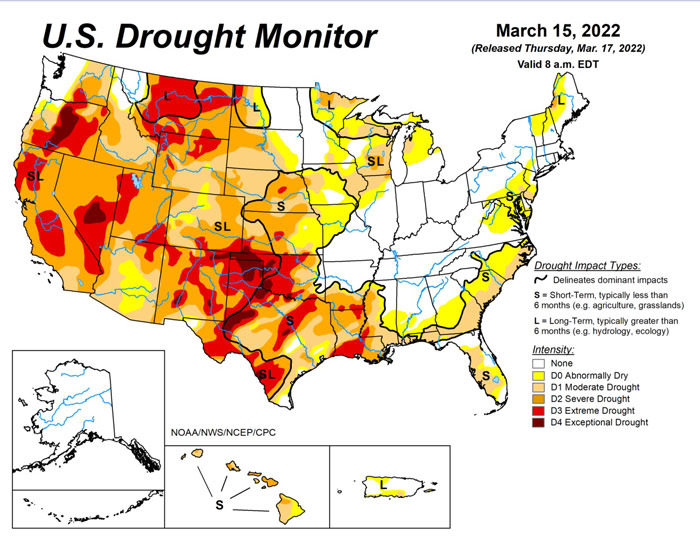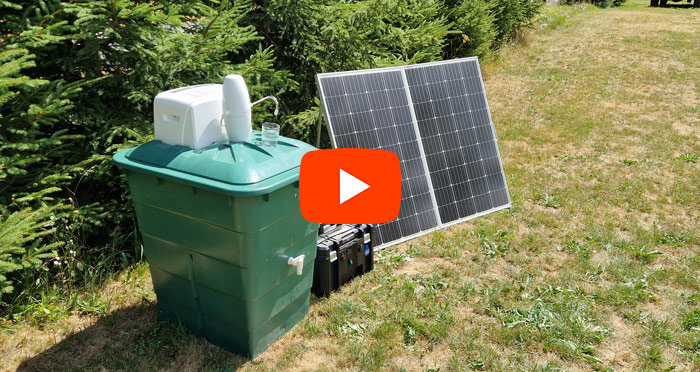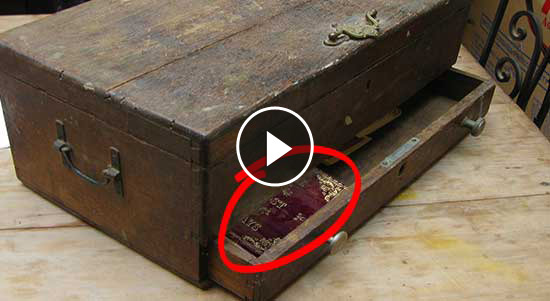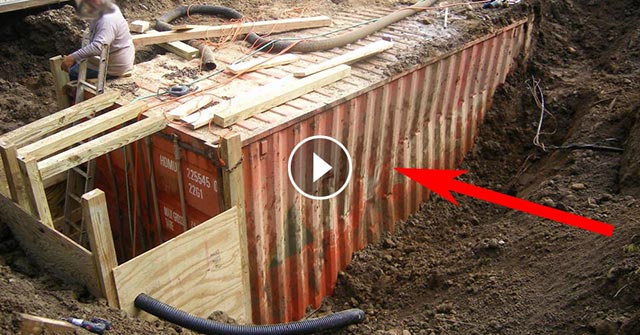Click Here To Join Our Telegram Channel for FREE daily tutorials!
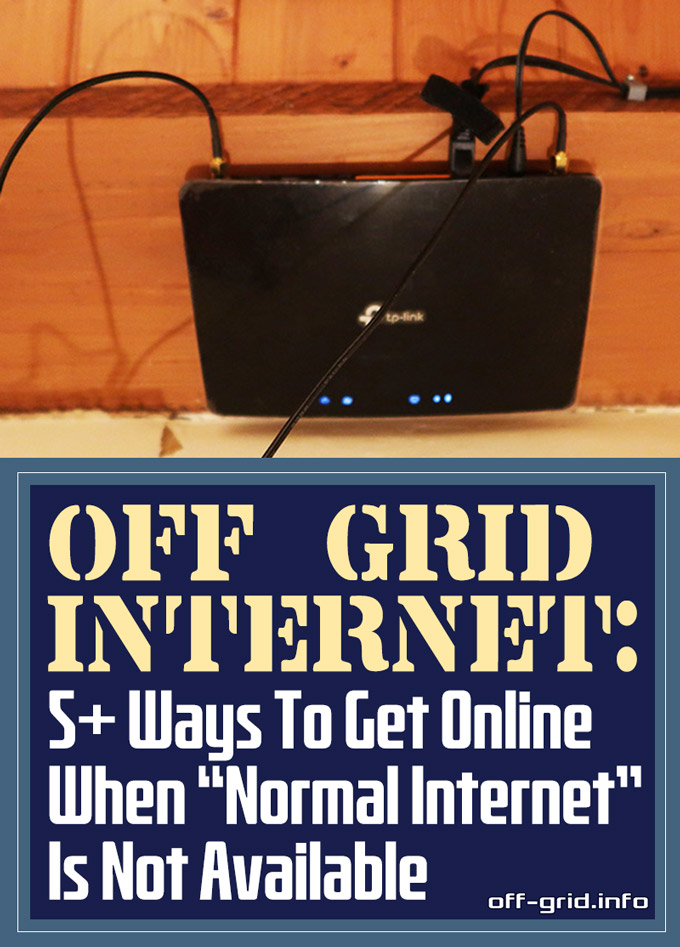
Doesn’t look like much, but this little TP-Link 4G Router saved the day when everything else failed! Full story below. Photo / graphic © off-grid.info
Off Grid Internet: 5+ Ways To Get Online When Normal Internet Is Not Available (Including SHTF Options)

Introduction
Internet access is pretty much a life-essential for the majority of people now – and in many cases it can be a make-or-break factor for whether a given location will be a viable option for work or general living.
I sure did find this out the hard way, when I moved to my place deep in the countryside… and learned that not only did I have barely any phone signal (0 to 2 bars, constantly going in and out), but that the “land line based” DSL internet was totally shot. 1Mb download speeds at best, with dropouts every few minutes. Downloading a large file was almost impossible. Not a word on any of this from the $500+ home appraisal surveyor, of course. The telecom companies literally would not fix it, either. I lost count of how many times I called their support, they “ran their tests”, told me it was dropping out over 100 times per day (yes I know), then a couple of days later they told me they had fixed it. All lies. They had not fixed anything! This went on for months until, exasperated, I explored all the other options I could think of… until finally finding a workable (ish) solution 18+ months later!
I tried multiple options, plus I have run an internet based business while bouncing between different countries for several years – so all in all I think I’ve learned a fair amount about this topic and have some useful tips to share…
Internet-Based Income = Freedom (So Long As You Can Get Online)
Ironically the recent “pandemic times” have probably been the first time in history where a large number of people had both the necessity to work remotely and the technology to be able to do so.

This combination of circumstances, together with the increased appeal of being truly “away from it all”, has opened more people’s minds to various off-grid possibilities than ever before. Why would you be in a city under lockdown when you could be out of town and still earn your money?
An internet based income is one of the key factors in this equation. It frees you from one of the predominant chains forcing you to be one place: The need to make money – which until very recent times required in pretty much all cases that you showed up at a certain location at a certain time, rain or shine.
While some jobs of course still necessitate this, more people than ever are working remotely. There are also innumerable internet based business opportunities nowadays.
For just one example, there are a number of folks, call them “road warriors” or “van lifers”, who run a Youtube channel documenting their adventures. If this is done well, the advertising revenue from Youtube can be a lifeline and a means to fund their life on the road.
But in order to do this – you gotta be able to get online! Solve that and the world is your oyster!
Ok so here are all the options I’ve explored. Let me know if you think of any others.

1. Starlink (fast but expensive, not available everywhere)
UPDATE: Starlink now has various options for people on the move. Comparison video / detailed review here: https://www.youtube.com/watch?v=dODc_lDy5TU
Here are the options:
1) Residential.
3) RV Standard. Review here: https://www.youtube.com/watch?v=N5I_Z86uZnU
3) RV In Motion.
4) Maritime.
Starlink – Elon’s mega satellite internet plan – has brought connectivity to various folks in remote parts of the world, which is of course a great thing. You could be in a forest, or even on an island, miles from anywhere – and still be able to get a fast connection. Gotta love that.
Pros:
• Super fast. Blazing speeds (well over 100Mb download) reported by numerous users. Competitive with or even better than fiber connections.
• True remote location possibilities – can work in wilderness areas with no other services available.
• Low Latency. Because the satellites are in low orbits, the “ping time” (the time it takes the signal to reach the dish) is much lower than with conventional satellite comms. 20ms claimed by Starlink, which is amazing.
Cons:
• Expensive. Setup is I think $499, with a price of around $100 per month after that.
• Fixed location [edit – see above, there are now options here]. Starlink’s standard residential package is fixed-location. You can’t just pack the dish in the back of the truck and head out of town. I’ve heard individuals claim that they took their Starlink dish on their adventure in the Black Rock Desert and got online! This might however have been an exceptional case; I am fairly sure that a number of Elon’s team go out to the desert for that lil’ thing called Burning Man and they might have rigged something so that they could get online. So make of it what you will.
• Not available in all areas – yet. They are still rolling it out and if it’s not in your area, well, you just have to wait. I signed up on the waiting list in early 2021 and waited nearly a whole year. Nada. Finally, exasperated, I cancelled (and got my deposit back without any fuss).
2. “Regular” Satellite Internet
I tried this one too! Honestly, I hated it. It was slow, kept cutting out and was fairly pricey. My life got ridiculous – at one point I had satellite that didn’t work, regular DSL that didn’t work and a cell phone that was out of range…. try dealing with that and managing an outsource team + 20 websites! Nightmare.
Satellite internet does work in general – and for those that rely on it, it’s a whole lot better than nothing. But for me it fell a long way short of desirable.
Pros:
• Can get you connected when there are no other options. If you are in a “remote part of a well populated country” then you will probably be able to sign up, get the dish delivered and get online without too much trouble. A remote island in the middle of the South Pacific, however? There are generally (expensive) services available for remote locations and ocean-going yachts; but getting delivery of the dish to Tristan da Cunha? Probably not going to happen! 🙂 You would have to get it handled before you go.
Cons:
• Data tariffs. I’ve yet to see “unlimited data” with satellite plans. Monthly plans typically come with a data limit. Once you chomp through your bandwidth, which is all too easy, you are booted onto the slow bus and get low speed until the beginning of the next month. It’s all done to get you to buy a bigger data plan…
• Not that fast, even with the “gold” package I was often getting only around 6MB/s on Speedtest.net
• Slow ping time. Mine was around 740ms as far as I can remember. Uploading a batch of web pages to a big website took hours.
• Hulking great dish, which needs to stay fixed and be pointed exactly at the satellite with no trees or anything in the way.
• Seemed to fail whenever it rained!
• Used a lot of power! The power pack for the dish was rated at 80W.
• The dish belongs to them. Which means you can’t even take your rage out on it when you finally lose your marbles and want to hit it with a 2×4. You don’t get that deposit back unless you ship it to them in one piece. The dish is huge. Just finding a sturdy box big enough for all of it was a real hassle and I still haven’t received my deposit back. So. Much. Hassle. Such. Crap. Support.
3. WiFi Leeching
Most people, these days, have their WiFi password-protected, and the good ole’ days of being able to leech Wifi from your blissfully-unaware neighbors are mostly long gone. Not that any of you good folks would do such a thing, of course. 🙂 You can still of course go to Wifi hotspots and connect there – for example, most cafes – however that means you have to go into town to get a connection, which gets old really fast. It can be useful in a pinch – and there are still plenty of road warriors who drive into town for the purpose of finding an internet cafe so that they can get caught up on their admin.
Pros:
• Typically Free. No power requirements, no contracts, no black boxes.
Cons:
• Inconvenience. You have to go where the WiFi is and stay there until you have done everything you needed to do.
A further option here is to get a long range WiFi antenna, which would enable you to connect to public (or non-password-protected) WiFi at a greater distance. More on that in section 6.
4. Mobile Phone Hotspot
The speeds of 4G (and even 3G) networks are actually not all that terrible. Many times when my satellite internet was failing I would get in the car with my laptop and phone, drive to the top of the hill and park up in a spot where I knew I could get 4 bars. It was faster than satellite and faster than my unbelievably crap DSL! There are lots of people in the world who rely on mobile hotspot to stay in touch with the world.
5. 4G Router + SMA Aerials + Unlimited Data SIM (Worked Best For Me!)
Now if someone had clued me in on this in 2019, they could have saved me almost 2 years of tearing my hair out in sheer frustration.
The main criteria with cellular reception are height – as in, the higher up you are above your immediate surroundings and whether there is stuff in the way – trees, walls, or metal (worst). Exploring every corner of my house in search of the best signal, I found that there was one spot at the top of my attic, near the ridge line, where I could get 2 to 3 bars on my phone with 3G. So for months I literally had the phone on a tripod in the attic, permanently plugged into a charger on an extension cord. It wasn’t all that great, but it was better than the flaky satellite. Then (without thinking) I insulated my attic with “isotherm” panels, which are foil-backed… and then that was the end of that.
Researching online, I discovered a 4G router on Amazon and it was a real game changer. I got EPIC results and completely solved my internet problems. So I am going to go into much detail on this one, because it could be a winner for a lot of folks.
The 4G router I found (link below) is a beauty. It literally has all the options I want:
1) Very small and portable.
2) You can disconnect the little stubby aerials and connect signal-boosting 4G antennae with SMA extension cables. This was the game changer – because you can get those aerials outside the building – which increases the signal strength significantly. This is mission critical if you are on the edge of service!
3) Runs from a 12vDC adaptor, which means it can connect to vehicle electrics and off grid power packs – oh yes!!
4) You can disable Wifi completely with a switch on the back of the unit and run in ethernet only mode (this is a game changer for anyone Wifi sensitive!)
5) Pop in a SIM with a monthly unlimited data plan and you are off to the races. Mine literally worked out of the box. Depending on the physical size of the SIM you have, you might need one of those tiny nano-SIM trays to get it to click into the 4G box, but this is an easy fix.
6) Some people are saying that they are getting this to work internationally: Reading reviews on Amazon, there are people who are using these in USA, Middle East and other places! I haven’t tried it but for international travelers it could be a win.
Here is the setup I purchased. I’ve given links to both UK and USA Amazon. Full disclosure, I earn (peanuts) commissions on purchases made via these links.
1) Unlimited data SIM.
I got a Vodaphone SIM and it worked right out of the box with the router, using an ethernet cable to connect to the computer. Rates always vary and you’ll likely be on a contract, but you should be able to get one for significantly less than the price of any of the other options! Alternatively you could use pay-as-you-go but after you’ve watched a couple of movies and burned through your data, you’ll want to get on unlimited I am sure.
2) 4G Router.
UK: TP-LINK AC1200 4G+ Cat6 Wireless Dual Band Gigabit Router, 4G/3G Network SIM Slot Unlocked. https://www.amazon.co.uk/gp/product/B083KDK9JC/ (£149.99)
USA: (similar, looks like 9v not 12v): https://amzn.to/32QjNwl – currently sold out.
Here’s a couple more for options to check out for the USA and other regions (not tested)
https://amzn.to/3G1Uw0m Cudy AC1200 Dual Band Unlocked 4G (“not for Verizon”)
https://amzn.to/338AUsQ Alcatel Link Hub 4G LTE Unlocked Worldwide HH41NH 150 Mbps
3) 4G LTE Antenna SMA Aerial (2-pack)
UK: https://www.amazon.co.uk/gp/product/B086JBRQC1/ £13.99
USA: https://amzn.to/3EYD0sN $11.99
(note that there is a legal disclaimer on the Amazon USA page that seems important. There seems to be some kind of legal restriction on the use of these signal boosters and a requirement of permission, although it lists major providers that have given “blanket consent to all boosters meeting the new certification standards.” (which from their wording one presumes this device does, although I don’t see that explicitly stated).
4) SMA WiFi Antenna Extension Cable 5M (2-pack)
UK: https://www.amazon.co.uk/gp/product/B073TXBS7V/ (£23.08 for 2)
USA: https://amzn.to/3qRqKVT ($19.98 for 2)
Installation: The 4G antennae are fantastic. Super low cost + they are small and light, about 12″ tall and weigh almost nothing. They have strong magnetic bases: I cut some 1″ wide strips of 1/16″ steel and bent them to a thin L-shape – so that I could slide them under the top-but-one roof tile and they would hook on. This worked beautifully and gave me a metal plate sticking out from the tile I could stick the antenna on to. I have a “proper” roof ladder so I went up there with my mobile phone and looked for a spot with the strongest signal. It was easy to get a very solid 3 to 4 bars.
I attached the 2 aerials about 8 feet apart from each other, close to the ridge line. Several months later and they have not budged! I then drilled a small hole in the wooden frame of my skylight window and ran the SMA cables through to the router, removed the SIM from my “attic phone” and popped it into the 4G router, ran an ethernet cable to my computer and… bingo. Download speeds around 10-15Mb/S during the day and around 20-25 at night.
Connecting the antennae and putting them on the roof of the house gave a massive signal boost. Huge. I was amazed. The first thing to note is that walls, roofs, metal boxes and other materials have a big damping effect on mobile phone signals. The second factor is height. When it comes to mobile phone networks, height is critical. My house here is in a “hollow” in between hills and also has a forest in between me and the nearest mobile phone tower, which is a couple of miles away. It’s a beautiful location and I am blessed – but useless for phone signal.
So if you can get your aerials outside those four walls and somewhere up high, you should be in good shape. I’d say I tripled or quadrupled the speed I was getting with just the mobile phone in the attic! If you want to experiment further, you could try some using kind of tripod or pole to get additional height. Just make sure that whatever you rig up is not going to become a danger if it gets windy. And these were of course cheapie antennae. I’m sure there are bigger and better if you are in the market for that.
Had this running now for about 3 months (in the UK) and there has been barely a drop-out. It has succeeded where all else failed.
Pros: (the advantages of this setup are numerous).
• Low cost. I got a Vodaphone unlimited data plan and it’s cheaper than DSL, cheaper than satellite, cheaper than all the other options I have found.
• Fairly fast. Running Youtube videos at 1080HD is now not a problem. No problems at all.
• Mobile. Wherever you have phone signal, you can exist. Plus with the aerials, you have much better capability than just mobile hotspot alone. I would imagine that for truckers, road warriors etc this setup would be peachy. And the fact that the 4G box I got was 12 volt was just the icing on the cake.
• Location tracking seems less than accurate. Google is guessing my location and they seem to be getting it wrong by about 150 miles. Oh, how this pleases me!
Cons:
• For best results you will want to get the little antennae outside and up high somewhere, which may involve drilling holes in things and climbing ladders. So be safe (and get some assistance if needed).
6. Post-Apocalypse Connectivity
This is of course all speculative and much of it depends on which grids go down – although there are some interesting options that may enable you to connect peer-to-peer without any grids at all. The key here is redundancy. In other words, for greater resilience you need more than one means of comms…
Let’s think first about power – because without power you are out of the game, and power blackouts are a real possibility, wherever you are. Get your “self-reliant comms power” handled first.
The good news is, this is relatively easy: Whereas a “whole house off grid” power setup requires a bank of solar panels, big batteries and a high ticket installation; your comms equip probably consists of low-powered devices. So small-medium solar panel + one of the modern generation of all-in-one portable power packs (get one with a pure sine output such as this 300w one from Go Labs (USA) or the Allpowers 288 (UK)) and you should be able keep your devices powered at all times – so long as you are using laptop / mobile tech and not desktop / mainframe computers. If you need more power, these portable power packs come in various sizes: Work out your wattage requirements, read the reviews and get the one that seems like it will best cover your required use.
Now let’s think about networks….
Mobile phone networks: Fairly resilient but have been known to go into blackout in the case of states of emergency. Cell phone towers, as far as I know, have backup power generators so that they can continue to function in case of power grid down. Still, to be prepared for a true SHTF scenario, you need a means to connect without them.
Satellite: “Ordinary satellite” internet inevitably requires that you connect to a specific satellite that is in geostationary orbit above your location, with the dish pointing right at the satellite. This creates a single point of failure. If the satellite goes off line (or gets taken out by a Bond villain), there goes the connection. Starlink on the other hand seems like it will be more reliable, though it’s too early to say, yet. This is because with a swarm of satellites, you’ll likely have more than one available to connect to at any given moment. So if one or even a few go pop, the network stays up. I’ve no idea how the signal routing on these works, though. Does it go from one dish to the satellite and then directly to another dish, in a peer-to-peer fashion? Or are all signals routed through a base station of some kind in Elon’s back yard? I think that the base station is more likely and of course means that the entire network has the possibility of failure or that someone, somewhere could ultimately disconnect you. Not ideal.
2 Way Radio / Walkie Talkie: Now as far as I know, these won’t work for internet, however for survivalists they are a fantastic option because they are peer-to-peer. In other words, if you and your buddy both have charge in the batteries, you can communicate without any other intermediary. So if every single grid goes down – power, mobile phone, satellite, cable modem… your 2-way radio will still reach other 2-way radios on the same band. Whether or not anyone has figured out a way to send internet data via 2-way radio, I do not know (and whether there is some legal restriction on this in some areas, I’ve absolutely no idea as I have never looked into this). But there’s an intriguing avenue of research here for the survival minded…
Ham Radio: Of course this enables communication and with correct licensing (if required in your region), you can communicate verbally. But what about internet? Well, it turns out that you can do this. Found a Youtube video of someone demonstrating how to surf the web using an Icom ID-1 D-Star ham radio:
This is an old video so things have probably progressed since then. I don’t know much about it and judging by the comments, it’s slow – but the potential here could be huge if all else fails. Absolutely no idea on legal restrictions so pls do your homework. But the possibility of being able to connect peer-to-peer via radio, with no ISP & no cell phone data plan required… that’s definitely interesting!
Here’s an interesting tutorial I found for what range you can get from ham radio.
Peer to Peer / Long Range WiFi. WiFi networking between computers is of course possible – however you are limited to the signal strength of your WiFi; which for most people is struggling by the time you get to the bottom of the garden! A quick search on long-range WiFi brought up this powerful CC Vector Extended Long Range WiFi Receiver System – which will, it is claimed, enable you to connect to a public WiFi up to 3 miles away in perfect, unobstructed outdoor conditions; with 1200 feet being a more realistic max range. One user claimed that using the above device in conjunction with RouterBOARD SXT G-2HnD CPE 802.11g/n 1600mW 10dBi gave a significant range boost, and another user of the RouterBOARD claimed 5 miles range with clear line-of-sight, which is amazing.
They also have a mobile version intended for RV / boat etc. It should in theory be possible to use this for peer-to-peer networking.
7. How To Run Your Business From A Mountaintop / Treehouse / etc.
Civilization? Is it ok to admit that I am losing interest? So my next mission here is to create a fully mobile setup based on the 4G router. I’d like to see a) how portable I can make it and b) how much extended range / distance away from mobile phone towers the aerials will give c) ways to increase this. The great thing about these 4G boxes is that they don’t use much power. With a 13″ laptop, one of these tiny 4G boxes, a portable LiFePo4-based all-in-one power pack such as this one (USA) or this one (UK), small solar panel and perhaps a light tripod for the aerials, I really might be able to put it all in a backpack and run my business from “wherever”… or how about a bug-out vehicle with full wired internet. I’ll post my results! In the meantime, it’s still a big, wide, beautiful world – so let’s get out and explore! 🙂
8. Internet On A Boat
I don’t know too much about this but it’s logical to predict that marine enthusiasts and ocean-going folks have put significant thought into this – and they know a lot about being a long way from civilization. I just found a great tutorial that would be a perfect entry to the topic. https://citimarinestore.com/citiguide/how-to-get-internet-on-your-boat-your-best-options/.
Turns out that with some of the marine signal boosters you can pick up cell phone towers up to around 8-10 miles offshore. Similar scenario for marina wifi services. I’d imagine that these devices don’t work quite as well on land because of “stuff in the way”, however they probably have very competitive range. There’s some fancy-looking hardware on that page, including routers that connect both wifi and cell signals, pulling from whichever is strongest. However, once you get past around 10 miles offshore, it’s down to satellite. Now this is where things get expensive. Of course, you are a yacht owner so spending another $1,400 to $30,000 on satellite hardware is no biggie. But now you can really be a Bond villain.
Final Thoughts
So there it is. In a few years, they will probably have figured all of this out. Not only Starlink but Amazon are in the process of deploying swarms of satellites, which no doubt will mean that in just a few years from now, you can be kept under observation anywhere on the planet, I mean, you will be able to get internet anywhere on the planet. Yay! “Connectivity everywhere” is a double-edged sword if ever there was one. And let’s hope nature doesn’t suffer as a result. Hmmm. Faraday cage bunkers? Deep tunnels? It’s all starting to sound good to me!

This Crazy Off Grid Device Literally Makes Drinkable Water From Fresh Air:
According to NASA, the U.S. is expecting a 100-YEAR LONG MEGADROUGHT.
It's already begun. Ask the farmers in California. They know.
Every survivalist knows that water is of critical importance. You NEED an independent water source that you can count on!
As an interesting "survival rehearsal" - imagine that you turned the tap on right now and nothing came out. How long would you last?
But what if there was another water source literally hidden in plain sight. That's right, I'm talking about the atmosphere!
The amazing thing about getting water from the natural moisture in the air... is that it is ALWAYS available.
This gives you real water security!
Learn more about how to tap into "Nature's secret water reservoir" and stay hydrated when TSHTF!
Watch the video:
😳 What Tinnitus Does To Your Brain Cells (And How To Stop It)
After 47 years of studies and countless brain scans done on more than 2,400 tinnitus patients, scientists at the MIT Institute found that in a shocking 96% of cases, tinnitus was actually shrinking their brain cells.
As it turns out, tinnitus and brain health are strongly linked.
Even more interesting: The reason why top army officials are not deaf after decades of hearing machine guns, bombs going off and helicopter noises…
Is because they are using something called "the wire method", a simple protocol inspired by a classified surgery on deaf people from the 1950s...
Most People Don't Have The Guts To Try This:
An amazing discovery in an abandoned house in Austin, Texas: A lost book of amazing survival knowledge, believed to have been long vanished to history, has been found in a dusty drawer in the house which belonged to a guy named Claude Davis.
Remember... back in those days, there was no electricity... no refrigerators... no law enforcement... and certainly no grocery store or supermarkets... Some of these exceptional skills are hundreds of years of old and they were learned the hard way by the early pioneers.
>> Click here to find out about them now
We've lost to history so much survival knowledge that we've become clueless compared to what our great grandfathers did or built on a daily basis to sustain their families.
Neighbors said that for the last couple of years Claude has tried to unearth and learn the forgotten ways of our great-grandparents and claimed to have found a secret of gargantuan proportions. A secret that he is about to reveal together with 3 old teachings that will change everything you think you know about preparedness:
>> Click Here To Watch The Video <<
What REALLY Happens When You Bury a Shipping Container? (Hint: It's A Bit Crazy...)
Shipping containers are all the rage - but if you are thinking about buying one, you MUST watch this video first:
Do not, I repeat do NOT do what these lunatics did! Can you spot the "fatal mistake" they made?
There's a general belief that if you bury a shipping container you can create an awesome root cellar / storm shelter / survival bunker.
But is a shipping container strong enough to handle the pressure?
Watch the video to see what happens:
What Really Happens When You Bury a Shipping Container? (Click To Watch Video)

I Can't Help Showing This Off:
If you haven't heard of Claude Davis yet do yourself a huge favor and watch this video.
One of the smartest guys I ever had the pleasure of meeting, Claude set-up a unique prepping system that changed his life forever.
I already tried it myself and let me tell... you I was completely blown away... His surprising tactics could make your life easier and give you the peace of mind you deserve.
Don't just take my word for it... watch his short video and decide for yourself.
>> Click Here To Watch The Video <<

More Off-Grid And Survival Resources:



